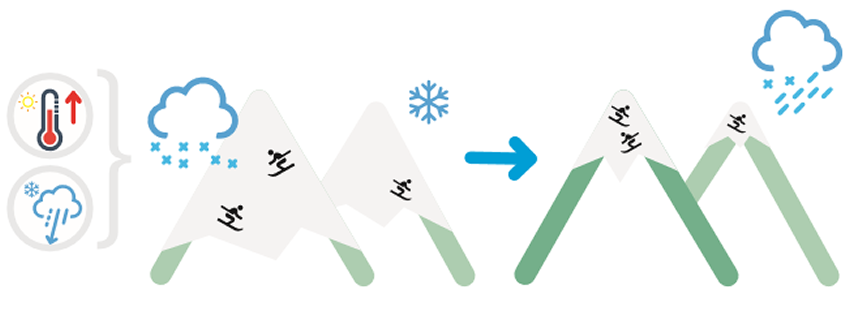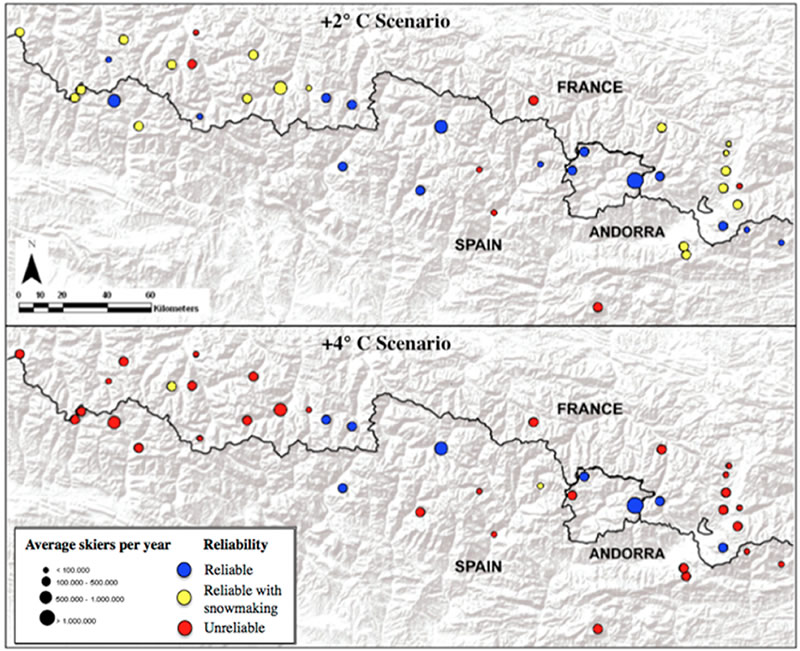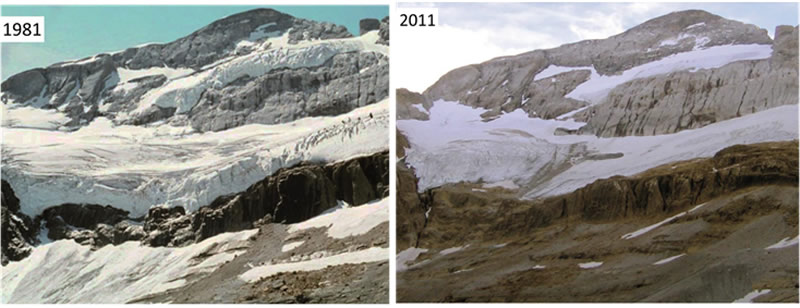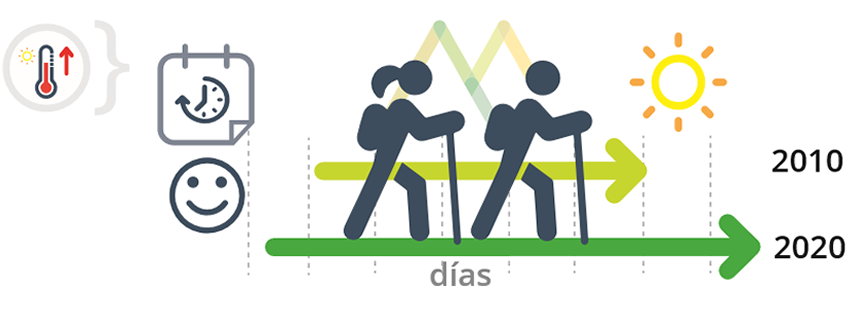For many tourists, climate conditions may determine how they plan their trip, orienting it towards a location with the ideal conditions for their chosen activity.
There are two specific and important aspects to the effect of climate change on the choice of tourism destination. Firstly, it can trigger direct effects in tourists linked to changes in thermal comfort. Secondly, climate change may also be decisive in determining the necessary conditions for certain activities (e.g. sufficient snow cover and thickness for skiing), and may cause environmental changes which have negative contextual effects. Specifically, aspects such as the presence or lack of certain emblematic fauna and flora, ecosystems quality, the state of iconographic natural formations and that of the environment in general could be affected by climate change and lead to a loss of tourism interest.
From the Pyrenees Climate Change Observatory, we highlight the following climate change impacts in tourism industry:
Reduction of winter tourism appeal of ski resorts

Winter tourism is the main source of income and the driving force of local development in many areas of the Pyrenees. However, in recent years this sector of the tourism industry has been identified as being extremely vulnerable to the effects of climate change.
Given the delay to the start of the snow season coincides with the period of greatest tourism demand, ski resorts are systematically forced to use artificial snow as a means of remaining operational. This has significant impacts on energy expenditure, not to mention the huge outlay in maintaining artificial snow machinery and environmental externalities associated with the growing water demand.
Furthermore, the increase in winter temperatures will also affect the ability to efficiently produce artificial snow, and lead not only to an increase in production costs but to a reduction in the number of suitable days for snowmaking.

Climate change impact assessments are not very encouraging for the sector, but there may be substantial differences in the level of sensitivity and vulnerability of ski resorts in the Pyrenees to climate change, based on their geographical, topographical and managerial characteristics.
Alteration of iconic elements of the Pyrenean landscape

Another possible impact of climate change on tourism in the Pyrenees is linked to landscape changes and particularly to the accelerated degradation of certain iconic features of the alpine landscape, such as peat bogs, glaciers and lakes.

Increased vulnerability of tourism infrastructure to hydrological and geological phenomena and to extreme weather events

The influence of climate change on hydrological and extreme events risks induced or increased by climate change is an element of instability capable of causing serious damage to infrastructure which is directly and indirectly related to tourism in the Pyrenees (hotel complexes and rural apartments, mountain refuge, telecommunication networks, mountain roads and tourism trails), and in some cases may jeopardise the integrity of local populations.
Lengthening of the mountain tourism season

Climate change could also have positive effects on mountain tourism. The longer summer season and progressively milder temperatures in spring and autumn, together with the minimum temperatures rise, could result in tourists opting for mountain destinations in place of others which will be progresivelly less thermically comfortable owing to higher temperatures.
Recommendations
Tourism in the Pyrenees is particularly vulnerable to the impacts of climate change. The magnitude of the projected impacts will depend in large part on the adaptation strategies adopted by the various involved parties (tourists, tour operators and management authorities) and on their capacity to implement adaptive management.
This section summarises the main climate change challenges facing the Pyrenees tourism sector :
-
Rethinking tourism models to strengthen the resilience of the sector against a future reduction in the number of skiable days and greater environmental pressure caused by its activities, whilst capitalising on emerging opportunities for nature and mountain tourism (mountain resort concept);
-
Reducing the vulnerability of tourism infrastructure to the possible increase in extreme and catastrophic hydrological, geological and climatic events, and safeguarding the physical integrity of tourists;
Strengthening environmental management strategies and plans to reduce the vulnerability of the ecosystems and biodiversity of the Pyrenees, with a focus on sensitive alpine ecosystems (tarns, glaciers, peat bogs, etc.); -
Ensuring balanced management of water resources in the tourism sector, particularly in basins supplied by rainwater.
PYRENEAN CLIMATE CHANGE OBSERVATORY
Avenida Nuestra Señora de la Victoria, 8
22.700 - Jaca
Huesca - España
+34 974 36 31 00
info_opcc@ctp.org




